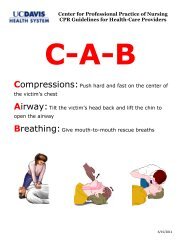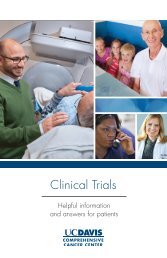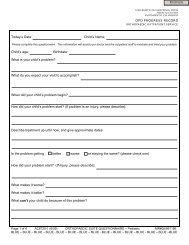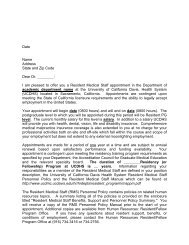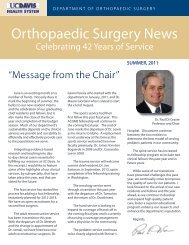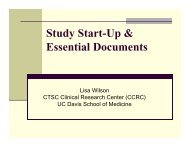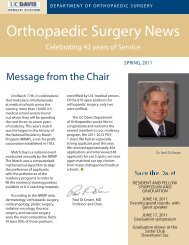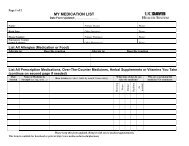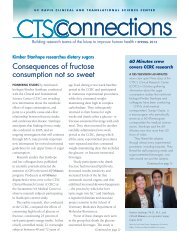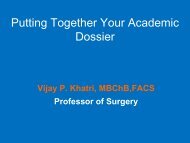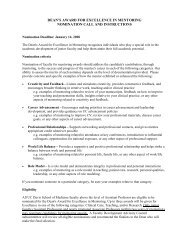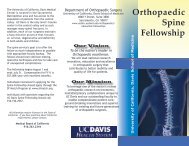Resident Handbook - UC Davis Health System
Resident Handbook - UC Davis Health System
Resident Handbook - UC Davis Health System
- No tags were found...
You also want an ePaper? Increase the reach of your titles
YUMPU automatically turns print PDFs into web optimized ePapers that Google loves.
To maximize learning opportunities, residents should “box-shop”, taking new cases out of order,asking the ED attending for advice as needed. <strong>Resident</strong>s should be alert for codes or patientsarriving by ambulance, helicopter, or being brought straight back from triage since most criticalpatients offer good learning opportunities. These cases must be discussed with the ED attendingprior to ordering therapeutic and diagnostic interventions. Although, residents will be grantedgreater autonomy with additional experience, part of the educational benefit comes from learninghow an experienced ED physician approaches clinical problems. Unstable patients may requireresuscitation prior to obtaining the entire H&P and diagnostic studies. <strong>Resident</strong>s may observecodes, but are encouraged to participate, as they feel comfortable, particularly intubations orother procedures. If residents are aware of a specific experience for which they need additionaltraining, they are encouraged to inform the attending at the beginning of the shift so the attendingcan direct the resident to those patients or discuss with Dr. Rawlings.<strong>Resident</strong>s are expected to be available to see patients during their entire shift and encouraged toask as many questions as needed. They must notify the ED staff when leaving the departmentfor any reason.<strong>Resident</strong>s will be evaluated on the following:Patient care- which includes gathering essential and accurate history and physical exam data,ordering appropriate tests, integrating medical facts with clinical data, formulating logical plans,and documenting appropriately. <strong>Resident</strong>s must present cases in a concise, logical, structured,appropriate manner. <strong>Resident</strong>s must see a minimum number of patients per shift according toyear of training: 0.5 patients per hour for R1s, 0.8 patients per hour for R2s, 1 patient per hourfor R3s. (e.g., In a 10 hour shift, R1s will see a minimum of 5 patients, R2s 8 patients, and R3s10 patients). These are minimum numbers with the expectation that residents will see more.1. To keep track of total numbers of patients seen, residents should keep a paper with thestickers of the patients they see and the diagnoses they encountered. If more than onediagnosis was addressed, please document and include any procedures performed. Bringthese to your meeting with Dr. Rawlings. Dr. Rawlings has created a simple form for thispurpose, which is included in the rotation folder. <strong>Resident</strong>s will also give Stacy Brewen acopy and the resident will hold on to the original for their own record.2. Medical knowledge- which includes formulating extensive differential diagnoses for allpatient problems, integrating biopsychosocial factors, and applying evidence-basedmedicine. <strong>Resident</strong>s will be encouraged to see patients throughout their rotation to getexposure to the broad curriculum of emergency medicine. A curriculum list will beincluded in your rotation folder for your reference. Reading topics have been included inthe rotation folder also. While they all are not required, they are strongly suggested andDr. Rawlings will meet periodically to assign readings and discuss. Please feel free touse the books and resources in the ED and online to further your learning about cases youhave encountered or other topics or skills. The text book where most of the readings arederived is, Harwood-Nuss’s “Clinical Practice of Emergency Medicine” Fifth Edition,2010. Others are from, Roberts and Hedges “Clinical Procedures in EmergencyMedicine” Fifth Edition 2010 and Tintinalli’s “Emergency Medicine: A comprehensiveStudy Guide” Seventh Edition 2010. A variety of other sources are included.3. Procedural skills- with attention to proficiency, patient comfort and safety. Noon conferencesPage 42 of 153C:\Documents and Settings\dhutak\Desktop\rshb13.doc




